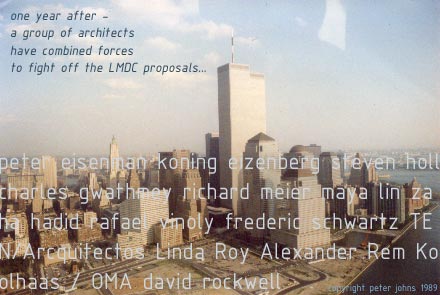
Herbert
Muschamp's design team has just published its work on the New
York Times website. (This site requires free registration).
The web pages are packed with names, ideas and images, and a busy
public forum.
The forum can be an interesting place to
start, as it shows some of the general directions of public thought
in relation to the site. There are still a number of gung-ho messages
that typified the immediate aftermath of the attack. "Build
it bigger and better - that'll show them".
There are also those who can't stomach the
thought of building anything on the site, apart from a park. Anything
commercial wouldn't work as it seems to conflict with the idea of
a memorial.
And then there are those that just want
to get on with it. Those for whom the site is a disturbing tabular
rasa that needs to be covered before the city can start to function
properly again. These people might cite the rebuilding of european
cities after the war as an example to follow.
The Muschamp team sprang from meetings of
a new New York 5 (this time Peter Eisenman, Richard Meier, Steven
Holl, Charles Gwathmey, and engineer Guy Nordenson). The meetings
were in response to the six safe urban designs that the Lower Manhattan
Development Corporation published a few months back. These designs
were nostalgic for an old New York. It was as if at last the site
could be brought back into the city, after almost four decades after
being abducted by a diseased modernism of inhumane towers and drafty
plazas. One of the stated goals of the LMDC is to, "restore
all or a portion of the street grid and reintegrate the former World
Trade Center site with the rest of downtown."
Perhaps the most offensive aspect of the LMDC approach for the NY5
was that it relegated the role of architect thought to almost an
afterthought, a decorator. There has always been tension between
planners, developers, urban designers and architects about who does
what and it seems to have boiled over here.
This site requires a solution incorporating
strong concepts that address issues that haven't been addressed
before in the States. These concepts require a lot of dirty argument
by experts and lay people. To facilitate this argument, radical
and extreme ideas are required, not the patternbook multi-choice
LMDC approach, a method reminiscent of choosing between display
homes.
The NY Times initiative is commendable because it tackles planning
and economic issues, it looks beyond the edges of the site and addresses
the whole of Lower Manhattan, and because it is obviously a work
in progress, presenting independent and conflicting ideas within
a fragile master plan. Apparently there were many rowdy meetings
and fax wars between the participants to come to a truce about how
the master planning should work. This is preferable to the application
of hundred year old city-planning rules to the site.
There seems to be one glaring omission from the NY Times process
though and this might have something to do with the project being
a reaction against the planning-led LMDC proposals. Where are the
planners and urban designers and landscape architects in the NYT
line up - they're all architects!? It's apparent in many of the
methods of presentation employed by these architects that some aren't
thinking much beyond their assigned buildings. They come across
as objects in space rather than objects and spaces within a city.
|